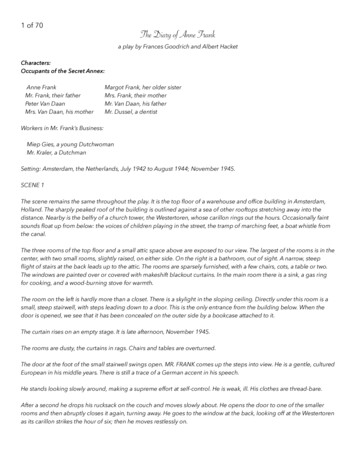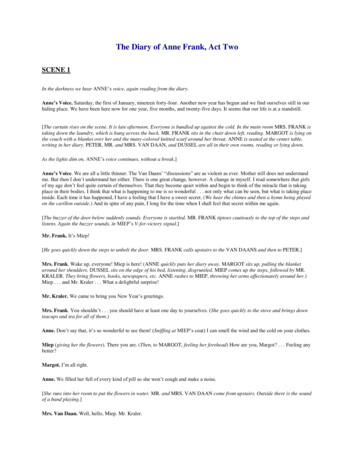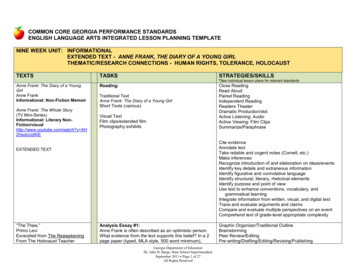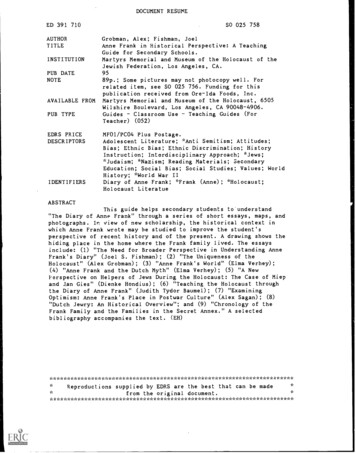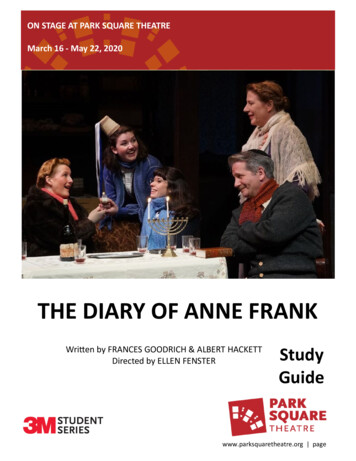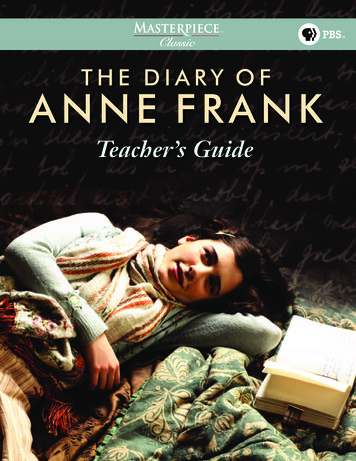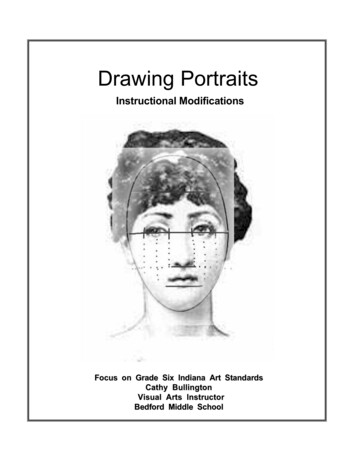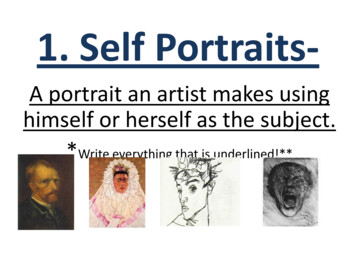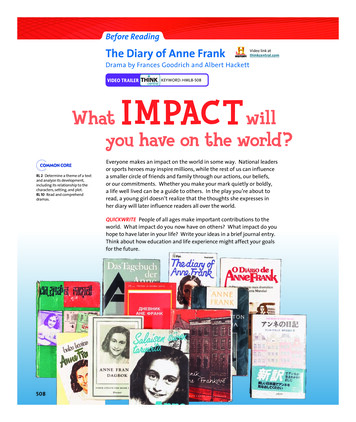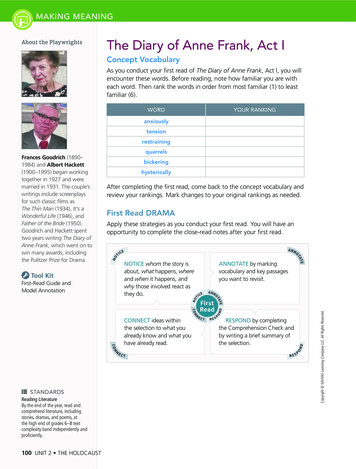
Transcription
UNIVERSITY OF WYOMING ART MUSEUM 2010Anne-Karin Furunes: Portraits of UnknownsPURPOSE OF THIS PACKET:QUESTION:To provide K-12 teachers with background informationon the exhibition and suggested age appropriateapplications for exploring the concepts, meaning, andartistic intent of the work exhibited, before, during, andafter the museum visit. Museum educators at the UWArt Museum (UAM) are available to tailor materialsto students’ developmental abilities and to work withteachers to address classroom goals and WyomingEducation Standards.Students will have an opportunity to read, write,sketch, listen to teachers and museum educators, andthen, to come up with questions about the work theysee, and the concepts behind the artwork and the artistwho created it. Students will question the materialsand techniques used and their own responses to the artwork in the exhibition.CURRICULAR UNIT TOPIC:Teachers and students examine the ideas, styles andtechniques of Norwegian artist Anne-Karin Furunes,whose large-scale portraits are created by perforating thesurface of canvas or paper. The focus of this educationalpacket and curricular unit is to observe, question,explore, create and reflect.OBSERVE:Students will closely observe the art work of AnneKarin Furunes, exploring the ideas and themespresented and/or the formal qualities of the work: thematerials and processes used; the size of the paintings;subject matter; style and techniques.EXPLORE:They will explore the background of the artist andhow that contributed to Furunes’ artwork. They will beencouraged to research vocabulary words and relatedaspects of the exhibit.CREATE:Students will be given time to practice sketching anddrawing, and may create their own self-portraits usingsimilar materials, either in the Shelton Studio or in theirschool art room.REFLECT:Students will evaluate their final art products withother students from their classes and with teachersand museum educators. They will receive feedbackon the art work and the concepts behind the makingof the art work. After this process, each person maywrite an essay about their art, the artist, or theirmuseum experience.
Anne-Karin Furunes: Portraits of UnknownsINTRODUCTIONIn this museum visit students will view theexhibition Anne-Karin Furunes: Portraits ofUnknowns. Norwegian artist Anne-Karin Furunes(b. 1961) incorporates images from historic recordsand archives to create works that address memory,culture, history, and photographic imagery. Theresulting portraits are created when the artistperforates the surface of black or white canvas orpaper with hundreds of holes. The images coalescefor the viewer, similar to the dot-screened images ina newspaper, or the pixels on a computer. Furuneshas exhibited extensively in Europe and has createda series of monumental works in Norway.HISTORYAnne-Karin Furunes was born in 1961 in θrland,Norway. She studied at the National Academy ofFine Art in Oslo, and is a professor and vice-deanat the Trondheim Art Academy in Norway. She hasshown her work extensively in Europe and Australia.Furunes had solo exhibitions at TrondheimKunstmuseum, Gallerie Traghetto Venezia,and Conny Dietzschold Gallery, Sydney. Groupexhibitions include those at The National Museumof Contemporary Art, Oslo, Barbican Art Center,London, and Art Basel Miami Beach. Furunes’swork is in the collection of many institutions,including The National Museum of China, Beijing,The National Museum of Contemporary Art, Oslo,and The Tromsρ Museum of Contemporary Art,Norway, The Museum of Contemporary Art Kiasma,Finland and The Museum of Art, Trondheim,Norway.[For this UAM exhibit], Furunes has drawnupon photographs of anonymous men and womendiscovered in found albums in a Swedish archivedevoted to now-discredited notions of categorizingpeople by race, ethnicity, and mental capacity.Among the images in the archive are subjects of aPage 2Anne-Karin Furunes (Norwegian, b.1961), Portraits of Pictures - Portrait 17,2007, acrylic on canvas, perforated, 88-1/4 x 63 inches, image courtesy ofBarry Friedman Ltd.fifty-year covert program conducted by the Swedishgovernment (and only exposed in the 1970s), whosemission was the forced sterilization of those labeled,“imbecile”, “deviant”, or “a burden to society.” Bypresenting faces from the archive, Furunes rescuesthem from a hidden bureaucratic system, restoringa sense of respect for their human dignity. In theartist’s words, “pictures become portraits.”[In other work] Furunes has pursued this notionof historical recovery with images ranging fromwomen who fought in the Finnish civil war of 1918,to Norwegian Jews who were deported by the Nazisat the start of World War II, to the very youngGerman soldiers sent to occupy Norway at the war’sEducation Packet
Anne-Karin Furunes: Portraits of Unknownsend, to the visages of contemporary people, givingthe viewer a chance to see their peers in a new andpoetic context.In her paintings, Furunes chooses faces,which suggest the presence of a real personality,enigmatic and ungraspable. Rather than explicitlyconveying emotion, these faces draw us in, makinga connection beyond language and identity. Furunesoften crops the images tightly, bringing the viewerinto an intimate relationship with each face.Furunes’s work evinces a range of metaphoricalreadings, emerging directly from its visual attributes.First, there is the mysterious appearance of a facefrom the painting’s flat surface. It is a phantom-likepresence, insubstantial, yet insistent, and dependenton the viewer’s movement and the play of light.This suggests the unknowable qualities of identityand the way that memory is lost and found. Whenviewed at close range, the image, which is cinematicin scale, dissolves into an abstract array of dots. At adistance the image is restored to our perception.The critic Mika Hannula noted this active aspectof looking at Furunes’s work: “You see the picture,how it changes, and you realize: sometimes it helpsto go a little further away so as to see a little moreclosely.You are in the end remaking the painting,re-describing it for that short moment as your place,your face, your memory–your version of reality.”Then, there is embodied in this sometimesfugitive work the historical implication of thosewho have been forgotten or purposely “disappeared”from public consciousness returning into view.Furunes has chosen subjects whose story has beendenied a hearing, and thus serves as a kind of publicmemory reasserting itself in the present.Finally, in Furunes’ painting there is a meditativeaesthetic which prompts the viewer to slowdown and attend to the workings of one’s ownconsciousness, to our capacity for constructingvisual illusion, and to the emptiness of real spacepervading the solidity of what we regard as real.Page 3- Notes accompanying the exhibit at the BerryFriedman Ltd. Gallery Space in Chelsea, September19 –November 10, 2007ARTIST STATEMENTSI started out painting and drawing, and then becamevery interested in photography. There were a lotof people working in photorealism, and I wasn’tinterested in that. I was looking for my own artisticlanguage, and a way to work large. People’s faces andthe mystery of exploring someone’s face fascinatedme. I’m not really sure why I choose one photo overanother. I’m not that interested in a smiling face,rather, I think I am searching for that direct gazethat conveys an inner strength, even in the faceAnne-Karin Furunes (Norwegian, b.1961), Portraits of Pictures - Portrait 18,2007, acrylic on canvas, perforated, 88-1/4 x 63 inches, image courtesy of BarryFriedman Ltd.Education Packet
Anne-Karin Furunes: Portraits of Unknownsof personal adversity. I’m not looking to create animage that celebrates violence already done to theseindividuals. I worry about that because I don’t wantto do harm again to these people. Instead, I amtrying to create a portrait, something positive forpeople who have gone through difficult, sometimeshorrendous experiences. I am trying to capture theiressence, to share their physical presence with theviewer. I want the viewer to see them as individuals,as if they were present in the room.I start by painting the canvas black (or white).Then I place the painted surface down, and grid theback of the canvas. From there I am able to transfermy drawing of the photograph (which you noticeI usually crop close to the face) using a variety ofdifferent sized punches to create different sizedholes. The larger the whole, the more the light willshow through from behind the canvas. I have tostop periodically and put it up to the wall and stepback so that I can see whether it is going the wayI want it to. I can’t tell from the back what it lookslike. It takes a long time, sometimes two months,to finish one portrait. And that doesn’t take intoaccount the time I spend in archives researching oldphotographs. That can take two years!- Anne-Karin FurunesIn discussions with UW Honors students, October 2010responding to the artwork and discussions in thegalleries, each student will try, in his or her ownway, to create something new. Students will beencouraged to incorporate their own ideas into theirwork.Before arriving at the art museum, students andteachers may research and engage in conversationsabout the artist, her home country of Norway,historical and social events alluded to in the artworkor the artist’s biographical material, the scienceof seeing patterns of “dots” as whole images (asin pointillism, printing processes and computerpixillations). While here they will spend time in thegalleries closely observing the work, discussing it,writing about it, and sketching it. They will beginconversations about the ideas and methods used tocreate the paintings, which will lay the groundworkfor future opportunities to pursue these ideas intheir home classrooms and schools.ESSENTIAL QUESTIONSGRADES K-6 LESSON OVERVIEWStudents will learn about the artist Anne-KarinFurunes and her work, considering the formalqualities and themes of her work. They willinvestigate the materials and techniques used bythe artist to create her portraits. Discussions andexplorations will be tailored to students’ age anddevelopmental levels, in consultation with theirclassroom teachers.In the Shelton Studio students will be giventhe opportunity to define and explore the idea ofa portrait or self-portrait. While inspired by orPage 4 What is a portrait?What is pointillism?How are these paintings like photographs?How are they different?Do these portraits look like people you mightknow? Why or why not.If you were to create a portrait of someone,who would it be? Why?GRADES 7-12 What do you notice first when you look atthese portraits? Why?These individuals each have their own history.Can you tell what that history is from theseportraits? Why or why not?Why has the artist chosen to portray thesepeople?How do artists help us learn about historicalEducation Packet
Anne-Karin Furunes: Portraits of Unknownsevents?ART QUESTIONS TO CONSIDERGRADES K-6 What do you see?Describe the kinds and types of marks theartist has made.How does the artist create shadow? How doesshe create lighted areas?GRADES 7-12 Why has the artist chosen to create such largeimages?How are the paintings on black canvas similarand/or different from the paintings on whitecanvas?How would the artist’s concept be affectedif she chose to use a different color for thesurface of the canvas?How would you use the same techniques tomake something new in art?PRE-VISIT ACTIVITIESIn order to prepare students for their museumvisit and extend learning possibilities, we suggestthat teachers and students consider the followingactivities. Students will read and research about theAmerican Modernists in art magazines, books, andon the web. Students may research information on AnneKarin Furunes on the Internet and the ArtMuseum’s website. Students may investigate the science of seeingwhole images that are made up of small points(pointillism, pixals, off-set printing). Students may research Norway and otherNorthern European countries, exploringsignificant political, economic, and historicalinfluences. Students may visit a historical archive to learnPage 5 more about how historic photos are preservedand how we use them to learn about the past.Students may explore the history of portraitart.PREREQUISITE SKILLS/KNOWLEDGEMuseum staff will work with teachers to ensure thatall projects are age and skills appropriate. At the veryminimum: Students should have some familiaritywith sketching and drawing objects, andphotography.MUSEUM ACTIVITIESThese activities are suggestions. Museum educatorswill work with teachers to carefully tailor all classesto their students’ needs, in support of classroomgoals and district and state education standards.PART 1TIME FRAME: 30 - 45 MINUTES(IN THE GALLERIES) Students will closely observe the works ofAnne-Karin Furunes on exhibit in the artmuseum. They will identify lines, shapes, forms,patterns, repetition, color, light and shadow,technique and style in the existing work. Students will discuss what they see withmuseum educators. They will explore the artist’s paintings inrelationship to the idea of photography,pointillism and printing and creatingsomething new. They will explore the concepts behind the artwork in the exhibit. Using worksheets, students will respond inwriting or drawing to the work they see byrecording their observations and their ownthoughts about the work.Education Packet
Anne-Karin Furunes: Portraits of Unknowns Students will answer questions on a museumworksheet.Students will engage in discussions about theirobservations and their answers and sketcheswith one another and with the teachers.PART 2TIME FRAME: 45 - 60 MINUTES(IN THE SHELTON STUDIO)The following projects may be consideredindividually, or combined, or museum staff willwork with teachers to develop specific projectswhich support ongoing classroom work. Students will explore the concepts andtechniques that Furunes uses to create her large-scale portraits (using photographs,drawing, and creating imagery by punchingholes in the surface of canvas or paper) tryingto make something new.Students will explore the idea of a portraitand create a self-portrait that conveys theirperception of self-identity.POST VISIT ACTIVITIESWe have found that students achieve maximumbenefit from a museum visit when time is scheduledfor post-visit activities. Here are some suggestions: Students discuss or write about their museumexperiences, reviewing what they learned,what has special meaning for them, how theywill use new information and skills. Students continue to research the works ofAnne- Karin Furunes (an essay, art work,research paper). Students create their own drawings, printsand paintings to investigate new ideas, whilebuilding on the ideas and methods explored atthe UAM. Students may research the science of seeingwhole images that are made up of small points(pointillism, pixals, off-set printing).SUGGESTED CURRICULUM USEThe study of the work of Annne-Karin Furunes tiesto multiple curricular areas, including art, history,social studies, writing, reading, international studies,sociology, and photography. Museum staff will workwith teachers to address specific Wyoming TeachingStandards and to align museum projects and studieswith ongoing classroom curricular units.SOME RECOMMENDED RESOURCESAnne-Karin Furunes (Norwegian, b.1961), Portraits of Pictures - Portrait13, 2007, acrylic on canvas, perforated, 88-1/4 x 63 inches, imagecourtesy of Barry Friedman Ltd.Page 6These are just a few of the many resources available.We welcome other suggestions that teachers andstudents find helpful which can be added to this list.Education Packet
Anne-Karin Furunes: Portraits of Unknowns UW Art Museum website: www.uwyo.edu/artmuseumExhibition descriptive materials (contactthe museum education program for moreinformation)Research on the Internet about Anne-KarinFurnunes.MATERIALS TO BE SUPPLIEDTO EACH STUDENTMaterials for selected Shelton Studio projects areprovided by the art museum.ASSESSMENT & DOCUMENTATIONIn order to ensure that our museum tour programis meeting the needs of teachers and students, wemay ask that participants help us assess the activitiesand learning that take place. Examples of evaluationtools include:1. Students will self-assess using a quick surveythat asks them to consider their response tothe gallery discussions and explorations, andtheir studio experience,2. Teachers will assess the overall visit bycompleting a quick-survey that asks for theirobservation and assessment of students’experiences, as well as assessment of theoverall process of the museum visit.3. Museum educators will record theirobservations and assessments.4. When studio time permits, we will askstudents to briefly discuss their art completedin the Shelton Studio.5. Museum staff may take photographs ofstudents and teachers to document thelearning taking place and the work producedduring a museum visit. These are availableto teachers upon written request for use inteaching and student portfolios.Page 7Education Packet
investigate the materials and techniques used by the artist to create her portraits. Discussions and explorations will be tailored to students’ age and developmental levels, in consultation with their classroom teachers. In the Shelton Studio students will be given the opportunity to define and explore the idea of a
